Informacje o artykule
DOI: https://www.doi.org/10.15219/em107.1683
W wersji drukowanej czasopisma artykuł znajduje się na s. 54-65.
 Pobierz artykuł w wersji PDF
Pobierz artykuł w wersji PDF
 Abstract in English
Abstract in English
Jak cytować
Winnicka-Wejs, A. (2024). Green Human Resource Management practices and the pro-environmental behaviour of employees in the TFL sector. e-mentor, 5(107), 54-65. https://www.doi.org/10.15219/em107.1683
E-mentor nr 5 (107) / 2024
Spis treści artykułu
- Abstract
- Introduction - review of literature on Green Human Resource Management
- Research methodology and description of respondents
- Environmental awareness and pro-environmental behaviour of TFL employees
- Perception of sustainability as a value
- Organisational and managerial support in the implementation of pro-environmental measures in the workplace
- Green Human Resource Management processes in TFL companies
- Green management - opinions of practitioners
- Conclusions
- References
Informacje o autorze
Green Human Resource Management practices and the pro-environmental behaviour of employees in the TFL sector
Alicja Winnicka-Wejs
Abstract
This article has cognitive value for the development of knowledge in the field of the sciences of management and quality, raising awareness of the ecological dimension of sustainable human resource management and providing the results of an own survey conducted within TFL sector entities in Poland. A survey questionnaire was developed for the purpose of the study, and a diagnostic poll based on a purposive sample and a statistical method analysis were applied. The survey data shows that the respondents from micro companies rate the environmental awareness level higher than middle-sized and large companies, and the pro-environmental behaviour of respondents from the TFL sector refers mainly to the basic level. In their view, the sustainability value is currently implemented to a limited degree. While performing pro-environmental activities in their workplace they rate organisational support higher than that of the managers. Green Human Resource Management processes are implemented in only one-third of the companies surveyed, and only 40% of the respondents believe that ecological objectives are truly executed and pro-environmental activities are important.
Keywords: GHRM (Green Human Resource Management), TFL (Transport-Forwarding-Logistics), sustainability, Green HR Practices, pro-environmental behaviour
Introduction - review of literature on Green Human Resource Management
Green Human Resource Management (GHRM) is the most widely explored sub-concept of Sustainable Human Resource Management in literature (Piwowar-Sulej, 2021a), occurring alongside the Triple Bottom Line approach of HRM, the common good and socially responsible HRM (Ehnert et al., 2020). Green HRM encompasses HRM practices that are aligned with environmental sustainability goals and are aimed at developing employee skills and their commitment to achieving these goals at the company level (O'Donohue & Torugsa, 2016). GHRM is a set of HRM practices that are friendly to the (internal and external) environment of the organisation and aim at the sustainable use of all kinds of resources (Bangwal & Tiwari, 2015).
A review of the foreign literature on the subject indicates that GHRM is currently considered an important topic in recent research (cf. Dumont et al., 2019; Jain & D'lima, 2018; Opatha & Kottawatta, 2020; Paillé, 2022; Ren et al., 2018; Renwick, 2018; Renwick et al., 2012; Renwick et al., 2015; Shah, 2019; Shen et al., 2018; Wagner, 2013; Yusoff et al., 2020; Zaid et al., 2020; Zoogah, 2011), and which requires practical exploration (Andjarwati et al., 2019). To date, research on Green Human Resource Management has focused on the themes of organisational and employee effectiveness, job satisfaction, attitudes towards the environment, green lifestyles, green organisational culture, and green empowerment, among others (more in: Łabędzki, 2022).
In the Polish literature on the subject, four monographs are worth citing: Bugdol and Stańczyk, 2021; Kozar, 2019; Piwowar-Sulej et al., 2023; Wojtczuk-Turek, 2022. The results of research on the implementation of Green HR Practices in contemporary companies are also interesting (cf. Matejun et al., 2020; Matusiak et al., 2020; Piwowar-Sulej, 2021b; Piwowar-Sulej, 2021a; Różańska-Bińczyk et al., 2020; Zaleśna & Wyrzykowska, 2017).
In Poland, Green Human Resource Management is mainly applied by large companies and corporations, following the example of companies operating in Western Europe. The leaders are those companies that have already implemented the ISO 14000 environmental management system (Różańska-Bińczyk, 2020). The analysis shows that Green HRM in Poland is still a relatively unknown initiative, not deeply rooted in the consciousness of Polish entrepreneurs, and that the model is at an early stage of maturity (cf. Bombiak, 2019; 2020a). It should be noted that this is a new model for the implementation of the HR function, the essence of which is to strive for a balance between economic rationality and social and ecological responsibility, which also represents a new trend in the field of HR (Bombiak, 2020b). Here, ecological goals are included in all sub-areas of HR management, from employment planning, recruitment, selection, motivation, staff development, to employee assessment and the impact on working conditions (Bombiak & Marciniuk-Kluska, 2018). It turns out that "green" can be the colour of business (Janik, 2021), and properly managed Green HRM can benefit both companies and employees (cf. Ackermann, 2017; Beck-Krala & Klimkiewicz, 2017; Kozar, 2017; Urbaniak, 2017).
Despite the fact that more and more is being said and written about ESG (Environmental, Social and Corporate Governance) and green HRM (Green Human Resource Management), there is a noticeable research gap in the area of knowledge of the implementation of green HRM processes in a specific industry, e.g. in the TFL (Transport - Forwarding - Logistics) sector, where Transport is a set of activities related to the movement of people and material goods using appropriate means (Fertsch, 2016c, p. 218), Forwarding - the organisation of the transport of cargo and the performance of all necessary related activities (Fertsch, 2016b, p. 189), and Logistics - the management of the processes of moving goods and/or people and the activities supporting these processes in the systems in which they occur (Fertsch, 2016a, p. 89) (more in: Dębkowska, 2017). For example, monographs in the field of logistics devote more space to the material elements of the logistics system, logistics processes rather than human resources and their management (cf. Bardy et al., 2016; Kauf et al., 2019; Kolasińska-Morawska & Sułkowski, 2022; Kozar & Matuszewska-Kubicz, 2022; Krawczyk, 2020; Tundys & Wiśniewski, 2018; Witkowski, 2010; Zowada, 2020). Additionally, conversations with practitioners (extra-mural students) during the Author's classes in the subject Logistics Management at the University of Economics in Katowice in the academic year 2021/2022 confirmed the Author's conviction that it is worth undertaking research in the field of Green Human Resource Management processes in the TFL sector.
Research methodology and description of respondents
The aim of the study is the scope of implementation of green HRM practices in the TFL sector and determining the perceived sustainability value in the TFL sector in Poland, and the utilitarian objective of the study is connected with the preparation of results to be used by both theoreticians and practitioners professionally related to the TFL sector. The following research questions were formulated:
- Q 1: What is the environmental awareness of employees in TFL companies and at what level is their pro-environmental behaviour in the workplace?
- Q 2: How is the value of sustainability perceived by employees in the TFL sector?
- Q 3: Do employees in the TFL sector receive adequate organisational and managerial support in implementing pro-environmental measures?
- Q 4: Which Green Human Resource Management processes are present and implemented in TFL companies?
- Q 5: What are the opinions of practitioners in the TFL sector on pro-environmental and sustainability practices?
A survey questionnaire consisting of 15 questions was constructed for the purposes of the study, inspired by the book Bugdol and Stańczyk (2021). The main constructs used in the study relate to Green Human Resource Management processes, environmental awareness, pro-environmental behaviour and sustainability values. Green Human Resource Management processes include recruitment and selection, adaptation and socialisation, employee education and training, performance management, pay and rewards, environmental engagement, green leadership, green HR (cf. Bugdol & Stańczyk, 2021), as well as green perceived organisational support (cf. Bugdol & Stańczyk, 2021). Environmental awareness has been recognised as one of the components of environmental measurements (cf. Alomari & Ibraheem, 2019) influencing the 'green behaviour' of employees (cf. Safari et al., 2018; Shah, 2019). Levels of pro-environmental behaviour were taken from a self-assessment questionnaire of pro-environmental behaviour (Bugdol & Stańczyk, 2021), while the value of sustainability was determined using 3 items from previously conducted studies (Herman et al., 2016).
The preparation of an online research tool, as well as nationwide research, was commissioned to the Research and Development Centre of the University of Economics in Katowice, whose service and research offer includes market and marketing research. The R&D Centre was selected, among other reasons, for its up-to-date and verified database of entities from the TFL sector, as it had previously carried out a project commissioned by the Ministry.
Prior to the start of the actual survey, which took place between 1 February 2022 and 22 February 2022, a pilot survey (on 16 January 2022) was conducted among practitioners, extramural students of the University of Economics in Katowice at the Logistics faculty, which enabled the content of the survey questions to be refined.
A link to the survey was sent to TFL sector entities operating in Poland, following phone calls requesting the completion of the survey. The territorial scope of the survey covered the entire country. According to the CSO's LDB, in 2019, there were 176,472 local entities in Section H (Transport and Warehousing), employing 944,719 people (GUS, n.d.). This section includes activities related to the transport of persons or goods performed by rail, pipeline, road, water or air transport, activities supporting transport provided by stations, ports, railway stations, bus stations, terminals for traffic control, handling of passengers, baggage and cargo, rental of transport equipment with a driver and crew, and postal and courier activities (Gofin, n.d.). A diagnostic survey was carried out using a single-sample survey with a survey questionnaire, which, due to the frequency of implementation, was defined as ad hoc. The research sample was purposive, consisting of entities from the TFL sector and using the R&D Centre database.
A total of 200 questionnaires were obtained, with the survey completed by 64% of men and 36% of women. The respondents included owners (9%), managers (27%) and professionals (64%), with 39% of respondents aged 40-49, 32% aged 30-39, 16% aged 50-59, 8% aged 29 or under, 2% aged 60 or over, and 3% not indicating an age. Respondents were also diverse in terms of their experience of working in the TFL industry, with most of them (44%) declaring work experience in the range of 6-15 years, followed by: several years - up to 5 years (26%), and 16-25 years (20%). 10% of respondents admitted to having more than 25 years of experience, including 26 to 35 years (9%), and 36 years and more (1%).
The majority of respondents worked in small and medium-sized companies, with only 16% working in large organisations (more than 250 employees). A more detailed split showed 19% working in companies with up to 9 employees, 41% in companies with 10 to 49 employees, and 24% in companies with 50 to 249 employees.
Responses were obtained from all 16 voivodeships: mazowieckie (36% of responses), łódzkie (20%), lubuskie (10.5%), małopolskie (7%), śląskie (6%), pomorskie (4%), wielkopolskie (2.5%), kujawsko-pomorskie (2%), podkarpackie (2%), opolskie, podlaskie, świętokrzyskie, zachodniopomorskie, dolnośląskie and lubelskie (1.5% each), and warmińsko-mazurskie (1%).
Environmental awareness and pro-environmental behaviour of TFL employees
At the beginning of the survey, respondents were asked to assess the level of environmental awareness of employees in the company they work for. Around 45% of the respondents assessed the environmental awareness of employees from TFL companies at an average level. On a scale of 1 (very low) to 5 (very high) - "3" occurred most frequently, as shown in Figure 1.
Figure 1
Assessment of the level of environmental awareness of employees in the companies the respondents work for

Source: author's own work.
Interestingly, there were differences in the assessment according to the size of employment in the company, with respondents from micro companies assessing the level of awareness as higher in comparison with medium and large companies (cf. Figure 2).
Figure 2
Assessment of the level of environmental awareness of employees in the company according to the size of employment in the respondent's company
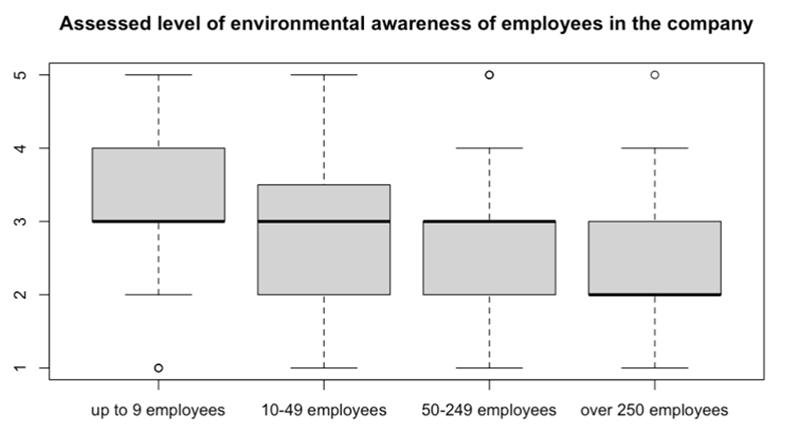
Source: author's own work.
The respondents also self-assessed their own pro-environmental behaviour in the workplace, as shown in Figure 3.
Figure 3
Self-assessment of own pro-environmental behaviour in the workplace according to respondents
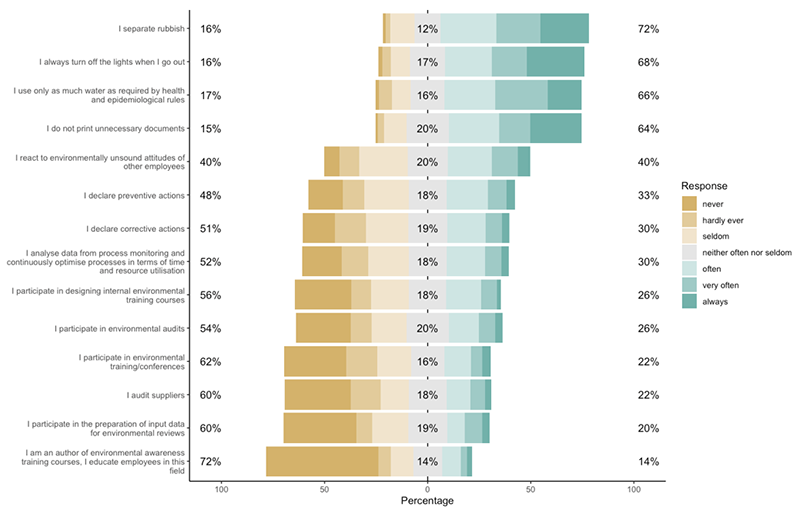
Source: author's own work.
Figure 3 shows that four activities (segregating rubbish, turning off the lights, using water appropriately, not printing unnecessary documents) are performed by the majority of respondents, although it should be emphasised that these are pro-environmental behaviours at the basic level (cf. Bugdol & Stańczyk, 2021). Behaviours from the systemic level (e.g. reporting preventive actions) or the active level (e.g. attending environmental conferences) are "never", "very seldom" or "seldom" performed. For example, 72% of the respondents have never or (very) seldom authored environmental awareness training, or education of employees in that field.
Perception of sustainability as a value
One of the survey questions concerned the perception of sustainability in the companies the respondents work for. The question "In your opinion, does the company you work for deserve to be labelled as a green sustainable company?" was answered in the affirmative by less than half of the respondents: 17.5% - "agree" and 28.5% - "moderately agree", while 35.5% evaluated their company negatively in this respect (9.5% - "disagree", 26% - "moderately disagree"). 18.5% marked the answer "neither agree nor disagree" (cf. Figure 4).
Figure 4
The structure of respondents' answers to the question "In your opinion, does the company you work for deserve to be labelled as a green sustainable company?"
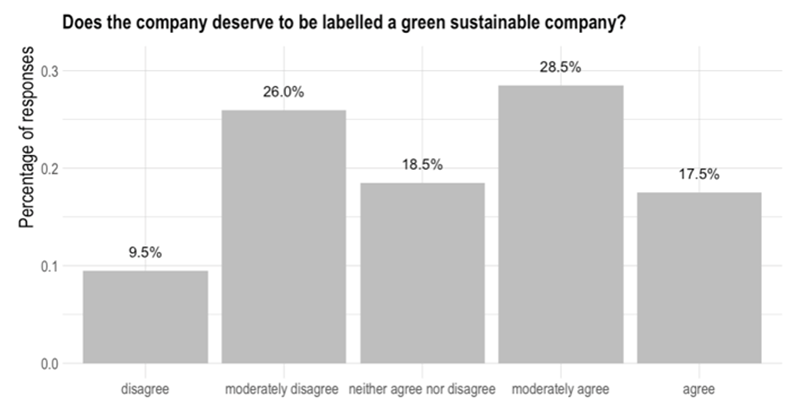
Source: author's own work.
Analysis of the obtained answers with the use of the Kruskal-Wallis test showed that the differences are only attributable to the size of the company, with respondents from the smallest companies (with up to 9 employees) more likely to say that their company deserved to be called a green sustainable company.
The next question was posed to check the extent to which the value of sustainability is a precious value that is taken seriously, with the content of the question taken from a study (Herman et al., 2016). The results of the answers to the question "Sustainability is:..." with an option of three choices are presented in Figure 5.
Figure 5
The structure of respondents' answers to the question "Sustainability is:... Please select the appropriate answer that reflects this value in your company"
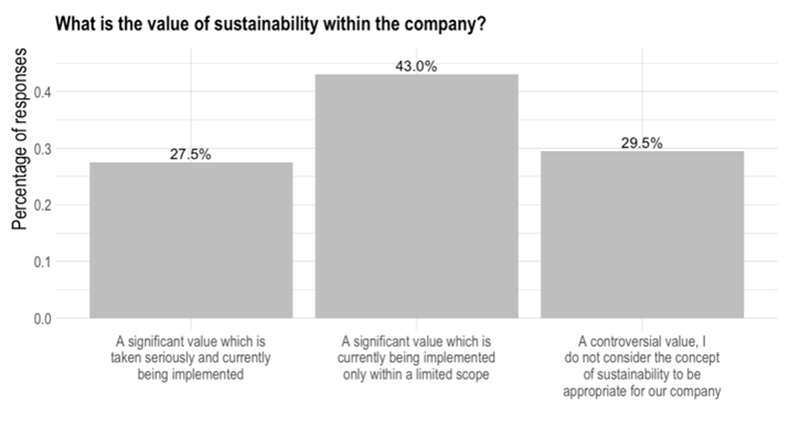
Source: author's own work.
As the presented results show, the perception of sustainability as a value is noticeable but implemented to a limited extent (43% of responses), with only 27.5% of respondents identifying sustainability as a precious value that is taken seriously in companies and is already being implemented. What is worrying is that for 29.5% of respondents, this value is controversial, as they believe that the concept of sustainability is not appropriate for the companies in which they are employed. The results obtained in this respect differ from those obtained in a survey conducted among 512 organisations in Poland in 2013 (cf. Herman et al., 2016).
An examination of the correlations between the metric variables and the assessment of the importance of the value of sustainability in the company using Chi-Square/Fisher's Exact Test of independence showed significant correlations, although very weak ones between the assessment of the importance of this value and the position and work experience in the TFL industry.
Organisational and managerial support in the implementation of pro-environmental measures in the workplace
Respondents from the TFL industry were also asked whether they receive adequate organisational and managerial (supervisor's) support in the implementation of pro-environmental measures in the workplace. The answers to this question are presented in Figure 6.
Figure 6
Organisational and managerial support in the implementation of pro-environmental activities in the workplace according to respondents from the TFL industry

Source: author's own work.
Figure 6 shows that respondents from the TFL industry assess organisational support as higher than managerial support, with half of them saying that they receive adequate organisational support in the implementation of pro-environmental measures in the workplace (18.5% - agree, 31.5% - moderately agree), and 43.5% being of the same opinion with regard to managerial support (19.5% - agree, 24.0% - moderately agree). By calculating the basic statistics, it emerges that in the case of organisational support the dominant, i.e. the most frequent response is "4" (moderately agree), while for managerial support it is "3" (neither agree nor disagree).
Green Human Resource Management processes in TFL companies
The answers to the question concerning the presence and implementation of Green Human Resource Management processes in TFL companies are interesting. Respondents' answers to this question are presented in Figure 7.
Figure 7
Green Human Resource Management processes in TFL companies according to respondents
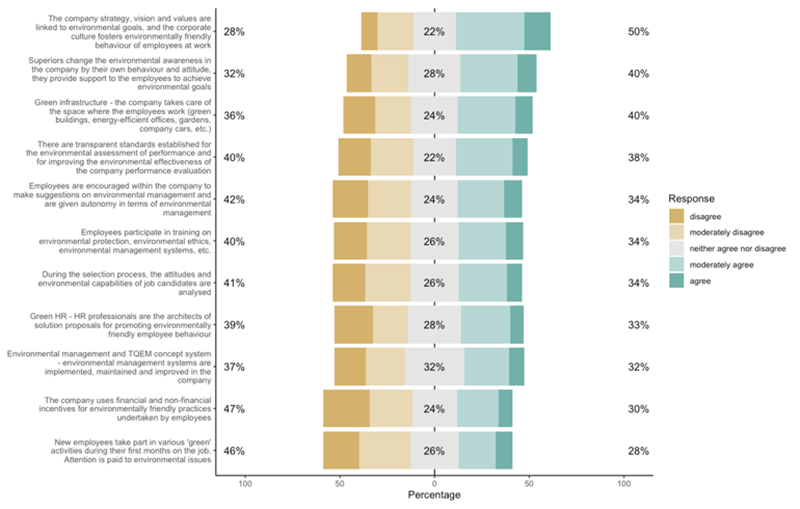
Source: author's own work.
As the data in Figure 7 shows, half of the respondents believe that the company's strategy, vision and values relate to green goals, and that the organisational culture fosters employees' green behaviour at work. Subsequently, 40% of the respondents are of the opinion that their superiors, by their own behaviour and attitudes, change the environmental awareness in the company, and provide support to employees to achieve environmental goals, although 32% are of the opposite opinion and do not see green leadership in their companies.
40% of respondents indicated that their companies take care of the space in which employees work - green buildings, energy-efficient offices, gardens, and company cars. In other words, green infrastructure is of importance to these companies.
Unfortunately, the results show that Green Human Resource Management processes are not yet present in most TFL companies, with only 38% of the respondents indicating that their companies have performance management with established transparent standards for green performance evaluation and improvement of the efficiency of green performance evaluation.
In practically only one in three companies: employees receive encouragement to make suggestions on environmental management and autonomy in terms of environmental management (green commitment); employees participate in training on environmental protection, environmental ethics, and environmental management systems (employee education and training); during the selection process, job candidates' environmental attitudes and capabilities are analysed (green recruitment and selection); HR professionals are the architects of solution proposals for promoting the pro-environmental behaviour of employees (green HR); environmental management systems and TQEM concepts are implemented, maintained and improved; financial and non-financial incentives are applied for environmentally-friendly practices undertaken by employees (payments and rewards); new employees take part in various "green" activities during their first months at work (green onboarding and socialisation).
The basic statistics in Table 1 show that the worst situation is in the area of remuneration - the dominant value is a negative "1"(disagree), and in the area of onboarding and socialisation of new employees - the dominant value is a negative "2"(moderately disagree).
Table 1
Basic statistics for the questions about processes of Green Human Resource Management in TFL companies
| Median | Mode | Quartile 1 | Quartile 2 | Quartile 3 | |
| The company strategy, vision and values are linked to environmental goals, and the corporate culture fosters environmentally friendly behaviour of employees at work. | 4 | 4 | 2 | 4 | 4 |
| During the selection process, the attitudes and environmental capabilities of job candidates are analysed. | 3 | 3 | 2 | 3 | 4 |
| New employees take part in various "green" activities during their first months on the job. Attention is paid to environmental issues. | 3 | 2 | 2 | 3 | 4 |
| Employees participate in training on environmental protection, environmental ethics, environmental management systems, etc. | 3 | 3 | 2 | 3 | 4 |
| There are transparent standards established for the environmental assessment of performance, and for improving the environmental effectiveness of the company performance evaluation. | 3 | 4 | 2 | 3 | 4 |
| The company uses financial and non-financial incentives for environmentally friendly practices undertaken by employees. | 3 | 1 | 2 | 3 | 4 |
| Employees within the company are encouraged to make suggestions on environmental management, and they are given autonomy in terms of environmental management. | 3 | 4 | 2 | 3 | 4 |
| Superiors change the environmental awareness in the company by their own behaviour and attitude, they provide support to employees to achieve environmental goals. | 3 | 4 | 2 | 3 | 4 |
| Environmental management and TQEM concept system - environmental management systems are implemented, maintained and improved in the company. | 3 | 3 | 2 | 3 | 4 |
| Green infrastructure - the company pays attention to the space where the employees work (green buildings, energy-efficient offices, gardens, company cars, etc.). | 3 | 4 | 2 | 3 | 4 |
| Green HR - HR professionals are the architects of solution proposals for promoting environmentally-friendly employee behaviour. | 3 | 3 | 2 | 3 | 4 |
Source: author's own work.
Green management - opinions of practitioners
The opinions of the respondents on green management in the TFL industry are quite diverse, with 40% believing that "in the company, we are honest in the implementation of environmental goals and pro-environmental activities are important to us", 34% emphasising that "in the company, there is no pro-environmental strategy, only economic goals count", and 23.5% believing that "the company only declares certain environmental practices, but in reality conducts so-called greenwashing, 2.5% of the respondents marking "other", writing the following sentences: "sometimes it is one way and sometimes the other", "procedures are in place because they are required by the EU", "only part of the management adjusts to the requirements of green management", "there are rules and regulations in the company, but people do not follow them", "it all depends on the employees themselves - procedures are there, but many/most employees do not follow them".
Figure 8
Opinions of respondents from the TFL industry on green management in companies
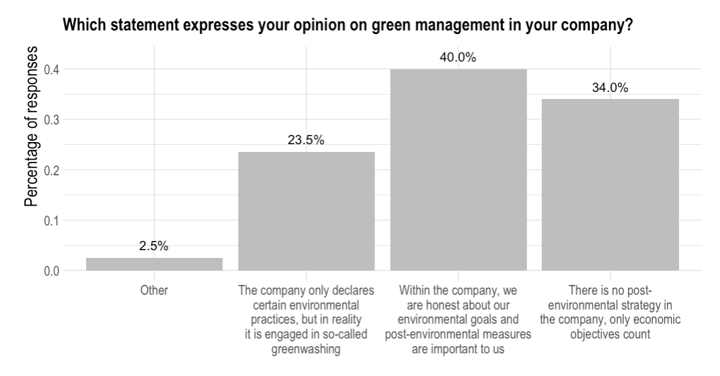
Source: author's own work.
It is worth noting the final, open-ended survey question, to which respondents were able to write their own comments on green practices and sustainability, with 42.5% of respondents using this opportunity and sharing their thoughts on the subject. The 85 responses obtained were grouped thematically and tabulated (cf. Table 2).
Table 2
Respondents' comments on green and sustainable development practices in TFL companies
| Thematic grouping of comments | Sample comments | Number of comments |
| Examples of green practices implemented in the organisation |
|
38 |
| Lack of a pro-environmental strategy and green practices |
|
15 |
| Cost barrier |
|
13 |
| Insufficient level of practice implementation |
|
10 |
| Low environmental awareness |
|
6 |
| Declaration of a "green" organisation without actual actions |
|
3 |
| Total | 85 | |
Source: author's own work.
The data in Table 2 shows that 38 respondents shared examples of good practices with regard to sustainability, and the picture emerging from a close analysis of these comments is one of TFL organisations that are predominantly taking action in the area of green infrastructure. What matters is the influence of foreign collaborators and the awareness and attitude of owners or managers. In these comments, Green Human Resource Management processes related to green leadership and performance management were evoked.
However, the majority of respondents who shared comments highlighted some limitations in the implementation of green and sustainable practices in the TFL industry. First of all, they observe a lack of any environmental strategy or activities in this area. In addition, they distinguished the issue of cost barriers, where economic considerations win out over sustainability. In the opinion of some of them, the level of implementation of environmental practices is insufficient and there is still much room for improvement in this area. There is also a need to change the environmental awareness of employees. Some companies declare their pro-environmental sustainability or want to be perceived as such, although they do not undertake any actions in this area.
Conclusions
The 2022 empirical survey of TFL sector players provided interesting findings on Green Human Resource Management processes, including answers to the following research questions, thus meeting the research objective:
- Q 1: The environmental awareness of employees in TFL companies is at an average level. The majority of respondents have a basic level of environmental behaviour in the workplace.
- Q 2: The value of sustainability is perceived in various ways by employees in the TFL sector. Most (43%) see it as valuable, but it is currently only implemented to a limited extent.
- Q 3: Half of the employees surveyed in the TFL sector receive organisational support in the implementation of environmental measures. Less than half (43.5%) may count on managerial support in this regard.
- Q 4: In the surveyed companies from the TFL sector, Green Human Resource Management processes (e.g. environmental involvement, employee education and training, green recruitment and selection) are present and implemented in one in three of them.
- Q 5: The opinions of surveyed practitioners from the TFL sector on green practices and sustainability are varied. 40% of them believe that environmental goals are fairly implemented in the company and that pro-environmental activities are important, while 34% are of the opinion that there is no pro-environmental strategy in the company and only economic goals count. It is also worrying that 23.5% assessed the company's actions as "greenwashing".
Respondents highlighted the excessive costs associated with implementing green practices, especially for small companies, and in the post-pandemic period. The TFL industry in Poland is looking at costs rather than ecology. Perhaps in the face of the importance of ESG, the growing expectations of sustainable business practices, and the risk of ending business relationships on this basis (including exclusion from tenders), actors in the industry will change their attitude and start to apply green practices more often and sign green contracts, which are still a novelty in Poland (more in: Puls Biznesu, 2022).
The survey shows that employees in the TSL industry do not get enough support from their superiors, and the need to deal with sustainability issues in organisations should be addressed with the concept of sustainable leadership (cf. Ferdig, 2007; Hallinger & Suriyankietkaew, 2018; Iqbal & Ahmad, 2021; Lee, 2017; Peterlin et al., 2015). Future research developments in this area should focus on specific practices undertaken at the organisational level and the implementation of specific tasks in this area (cf. CISL, n.d.).
The resulting comments on pro-environmental practices are in line with other findings from studies conducted in Poland - they are not always carefully planned (cf. Lulewicz-Sas & Zubek, 2022; Wielewska, 2023). There is work to be done in the analysed area, and changes in companies' practices are inevitable due to the need to protect the environment and pressures from various stakeholders (cf. Piwowar-Sulej, 2021b).
In the not-too-distant future, all companies, including those in the TFL sector, will be forced to take action in the area of sustainability and operate with regard to the world we will leave behind for the next generations, who are increasingly aware of and interested in "being green" (cf. Muszyńska, 2021).
The survey had a number of limitations that are worth mentioning. Due to the fact that the research sample was non-random, one has to be careful when formulating conclusions, as it is not legitimate to generalise them. Only 200 responses were obtained, which impacts the issue of representativeness, which means that the research sample characteristics are not representative for the whole population of TFL entities. Moreover, the empirical research was conducted in 2022 and its results are likely to be different today, taking into account the change in the ecological awareness in the sector that was surveyed. The data analysis employed basic statistical tools, such as mean and median, as well as the Mann-Whitney U Test and Kruskal-Wallis Test. The research did not pose any research hypotheses, nor did it utilise a more sophisticated research model or more advanced SPSS tools.
Further research in the field of Green Human Resource Management processes should be continued in the direction of qualitative presentations of case studies from the TFL sector, and based on specific practices in selected sections of the Transport and Warehousing Industry; it could, for instance, analyse railway transport and road transport separately. The implementation of selected HR processes in the TFL sector could be made more specific by focusing on a given area, such as the environmental training of employees. The plenary session "Trends and Practices of Sustainable HRM in Organisations" (SGH, 2024) may inspire further research in the field.
References
- Ackermann, K. F. (2017). Exploring Green Human Resource Management: Knowledge-based state of the art. Zarządzanie Zasobami Ludzkimi, 6, 21-39.
- Alomari, M., & Ibraheem, A. (2019). Enviromental performance measurement. Review of indicators and obstacles. International Journal of Financial Management, 9(3), 1-8.
- Andjarwati, T., Budiarti, E., Audach, A. K., Khouri, S., & Rębilas, R. (2019). The impact of Green Human Resource Management to again enterprise sustainability. Polish Journal of Management Studies, 20(2), 93-94. https://doi.org/10.17512/pjms.2019.20.2.08
- Bangwal, D., & Tiwari, P. (2015). Green HRM - A way to greening the environment. Journal of Business and Management, 17(12), 45-53.
- Bardy, E. J., Coyle, J. J., & Langlay, C. J. Jr. (2016). Zarządzanie logistyczne. Polskie Wydawnictwo Ekonomiczne.
- Beck-Krala, E., & Klimkiewicz, K. (2017). Reward programs supporting environmental organizational policy. Zarządzanie Zasobami Ludzkimi, 6, 41-54.
- Bombiak, E. (2019). Green Human Resource Management - the latest trend or strategic necessity? Entrepreneurship and Sustainability Issues, 6(4), 1647-1662. https://doi.org/10.9770/jesi.2019.6.4(7)
- Bombiak, E. (2020a). Advances in the implementation of the model of sustainable Human Resource Management: Polish companies experience. Entrepreneurship and Sustainability Issues, 7(3), 1667-1687. https://doi.org/10.9770/jesi.2020.7.3(16)
- Bombiak, E. (2020b). Nowe trendy w obszarze funkcji personalnej. Wydawnictwo Naukowego Uniwersytetu w Siedlcach.
- Bombiak, E., & Marciniuk-Kluska, A. (2018). Green Human Resource Management as a toolfor the sustainable development of enterprises: Polish young company experience. Sustainability, 10(6), 1739. https://doi.org/10.3390/su10061739
- Bugdol, M., & Stańczyk, I. (2021). Zielone zarządzanie ludźmi. Green HRM. Difin.
- CISL. (n.d.). Leading with sustainable purpose: Leaders' insights for the development, alignment and integration of a sustainable corporate purpose. Cambridge Institute for Sustainability Leadership. Retrieved March 14, 2023, from https://www.cisl.cam.ac.uk/system/files/documents/aligning-and-integrating.pdf
- Dębkowska, K. (2017). E-logistics as an element of the business model maturity in enterprises of the TFL sector. Procedia Engineering, 182, 143-148. https://doi.org/10.1016/j.proeng.2017.03.141
- Dumont, J., Deng, X., & Shen, J. (2019). Green Human Resource Management in Chinese Enterprises. Routledge. https://doi.org/10.4324/9780429286971
- Ehnert, I. A., Matthews, B., & Muller-Camen, M. (2020). Common good HRM: A paradigm shift in Sustainable HRM? Human Resource Management Review, 30(3), 100705. https://doi.org/10.1016/j.hrmr.2019.100705
- Ferdig, M. A. (2007). Sustainability leadership: Co-creating a sustainable future. Journal of Change Management, 7(1), 25-35. https://doi.org/10.1080/14697010701233809
- Fertsch, M. (red.). (2016a). Logistyka. In Słownik terminologii logistycznej z indeksem angielsko-polskim i polsko-angielskim (p. 89). Biblioteka Logistyka. Instytut Logistyki i Magazynowania.
- Fertsch, M. (red.). (2016b). Spedycja. In Słownik terminologii logistycznej z indeksem angielsko-polskim i polsko-angielskim (p. 189). Biblioteka Logistyka. Instytut Logistyki i Magazynowania.
- Fertsch, M. (red.). (2016c). Transport. In Słownik terminologii logistycznej z indeksem angielsko-polskim i polsko-angielskim (p. 218). Biblioteka Logistyka. Instytut Logistyki i Magazynowania.
- Gofin. (n.d.). Sekcja H - Transport i Gospodarka Magazynowa. Retrieved February 28, 2022, from http://www.klasyfikacje.gofin.pl/pkd/5,1,1516,transport-i-gospodarka-magazynowa.html#sekcja
- GUS. (n.d.). Pracujący w gospodarce narodowej wg sekcji PKD, płci i miejsca zamieszkania (dane miesięczne). Bank Danych Lokalnych. Retrieved February 1, 2022, from https://bdl.stat.gov.pl/bdl/metadane/cechy/szukaj?slowo=Pracuj%c4%85cy%20w%20gospodarce%20narodowej%20wg%20sekcji%20PKD
- Hallinger, P., & Suriyankietkaew, S. (2018). Science mapping of the knowledge base on sustainable leadership, 1990-2018. Sustainability, 10(12), 4846. https://doi.org/10.3390/su10124846
- Herman, A., Oleksyn, T., & Stańczyk, I. (Eds.). (2016). Zarządzanie respektujące wartości: raport z badań. Difin.
- Iqbal, Q., & Ahmad, N. H. (2021). Sustainable development: The colors of sustainable leadership in learning organization. Sustainable Development, 29(1), 108-119. https://doi.org/10.1002/sd.2135
- Jain, N., & D'lima, C. (2018). Green HRM - a study on the perception of Generation Y as perspective internal customers. International Journal of Business Excellence, 15(2), 199-208.
- Janik, M. (2021, August 13). Zieleń zaczyna być kolorem biznesu. Polskie firmy wreszcie chcą być eko. Rzeczpospolita. https://klimat.rp.pl/walka-o-klimat/art18708281-zielen-zaczyna-byc-kolorem-biznesu-polskie-firmy-wreszcie-chca-byc-eko
- Kauf, S., Kramarz, M., & Sadowski, A. (2019). Zarządzanie marketingowo-logistyczne. Kontekst zrównoważonego rozwoju. Wydawnictwo Naukowe PWN.
- Kolasińska-Morawska, K., & Sułkowski, Ł. (2022). Logistyka oczami kobiet. Difin.
- Kozar, Ł. J. (2017). Shaping the green competence of employees in an economy aimed at sustainable development. Zarządzanie Zasobami Ludzkimi, 6(119), 55-67.
- Kozar, Ł. J. (2019). Zielone miejsca pracy. Uwarunkowania - identyfikacja - oddziaływanie na lokalny rynek pracy. Wydawnictwo Uniwersytetu Łódzkiego.
- Kozar, Ł. J., & Matuszewska-Kubicz A. (Eds.) (2022). Branża TSL wobec wyzwań zrównoważonego rozwoju - wybrane aspekty. Wydawnictwo Uniwersytetu Łódzkiego.
- Krawczyk, S. (2020). Podstawy logistyki (ed. 2). CeDeWu.
- Lee, H.-W. (2017). Sustainable leadership: An empirical investigation of its effect on organizational effectiveness. International Journal of Organization Theory and Behaviour, 20(4), 419-453. https://doi.org/10.1108/IJOTB-20-04-2017-B001
- Lulewicz-Sas, A., & Zubek, M. (2022). Teoria i praktyka zrównoważonego rozwoju. In A. Wojtczuk-Turek (Ed.), Zarządzanie kapitałem ludzkim w warunkach zrównoważonego rozwoju (pp. 13-38). Wydawnictwo Naukowe PWN.
- Łabędzki, R. (2022). Zrównoważone zarządzanie kapitałem ludzkim i zielone ZKL - założenia koncepcji i stosowane w firmach praktyki. In A. Wojtczuk-Turek (Ed.), Zarządzanie kapitałem ludzkim w warunkach zrównoważonego rozwoju (pp. 39-56). Wydawnictwo Naukowe PWN.
- Matejun, M., Matusiak, B. E., & Różańska-Bińczyk, I. (2020). Praktyki green HR a wyniki środowiskowe współczesnych przedsiębiorstw. In J. Cewińska, A. Krejner-Nowecka, & S. Winch (Eds.). Zarządzanie kapitałem ludzkim - wyzwania (pp. 61-76). Oficyna Wydawnicza SGH.
- Matusiak, B. E., Matejun, M., & Różańska-Bińczyk, I. (2020). Koncepcja zrównoważonego rozwoju jako środowisko implementacji praktyk "green HR" we współczesnych przedsiębiorstwach. In M. Urbaniak, & A. Tomaszewski (Eds.). Wyzwania społeczne i technologiczne a nowe trendy w zarządzaniu współczesnymi organizacjami (pp. 111-124). Oficyna Wydawnicza SGH.
- Muszyńska, W. (2021). Stosunek przedstawicieli pokolenia Y do inicjatyw z zakresu zielonego zarządzania zasobami ludzkimi. Edukacja Ekonomistów i Menedżerów, 60(2), 73-87. https://doi.org/10.33119/EEIM.2021.60.5
- O'Donohue, W., & Torugsa, N. A. (2016). The moderating effect of 'Green'HRM on the association between proactive environmental management and financial performance in small firms. International Journal of Human Resource Management, 27(2), 239-261. https://doi.org/10.1080/09585192.2015.1063078
- Opatha, H. H. D. P. J., & Kottawatta, H. (Eds). (2020). Green HRM, Green Attitude and Green Work Behavior of Employees: An Empirical Study in a Sri Lankan Tiles Manufacturing Company. Proceedings of Undergraduate Research Symposium, 1-8.
- Paillé, P. (Ed.). (2022). Green Human Resource Management research. Issues, trends, and challenges. Palgrave Macmillan.
- Peterlin, J., Pearse, N., & Dimovski, V. (2015). Strategic decision making for organizational sustainability: The implications of servant leadership and sustainable leadership approaches. Economic and Business Review, 17(3), 273-290. https://doi.org/10.15458/85451.4
- Piwowar-Sulej, K. (2021a). Core functions of Sustainable Human Resource Management. A hybrid literature review with the use of H-Classic methodology. Sustainable Development, 29(4), 671-693. https://doi.org/10.1002/sd.2166
- Piwowar-Sulej, K. (2021b). The practice of Green HRM in Poland - with the focus on elements of the HR function. Annales Universitatis Mariae Curie-Skłodowska, 55(2), 75-84.
- Piwowar-Sulej, K., Bąk-Grabowska, D., Grzesik, K., & Zając, Cz. (2023). Zrównoważone Zarządzanie Zasobami Ludzkimi - wybrane zagadnienia. Wydawnictwo Uniwersytetu Ekonomicznego we Wrocławiu.
- Puls Biznesu. (2022, October 25). W logistyce i łańcuchach dostaw rośnie znaczenie ESG. https://www.pb.pl
- Ren, S., Tang, G., & Jackson, S. E. (2018). Green Human Resource Management research in emergence: A review and future directions. Asia Pacific Journal of Management, 35(3), 769-803. https://doi.org/10.1007/s10490-017-9532-1
- Renwick, D. W. S. (Ed.). (2018). Contemporary developments in Green Human Resource Management research: Towards sustainability in action? Routledge. https://doi.org/10.4324/9781315768953
- Renwick, D. W. S., Jabbour, C. J., Muller-Camen, M., Redman, T., & Wilkinson, A. (2015). Contemporary development in Green (environmental) HRM scholarship. The International Journal of Human Resource Management, 27(2), 114-128. https://doi.org/10.1080/09585192.2015.1105844
- Renwick, D. W. S., Redman, T., & Maguire, S. (2012). Green Human Resource Management: a review and research agenda. International Journal of Management Reviews, 15(1), 1-14. https://doi.org/10.1111/j.1468-2370.2011.00328.x
- Różańska-Bińczyk, I. (2020, September 23). Green HRM - "zielone" zarządzanie zasobami ludzkimi. Sposób na zrównoważony rozwój firmy. https://ksiegowosc.infor.pl/zus-kadry/inne/4690505,Green-HRM-zielone-zarzadzanie-zasobami-ludzkimi-Sposob-na-zrownowazony-rozwoj-firmy.html
- Różańska-Bińczyk, I., Matejun, M., & Matusiak, B. E. (2020). Praktyki green HR we współczesnych przedsiębiorstwach. In J. Cewińska, A. Krejner-Nowecka, & S. Winch (Eds.), Zarządzanie kapitałem ludzkim - wyzwania (pp. 77-91). Oficyna Wydawnicza SGH.
- Safari, A., Salehzadeh, R., Panahi R., & Abolghasemian, S. (2018). Multiple pathways linking environmental knowledge and awareness to employees'green behavior. Corporate Governance, 18(1), 81-103. https://doi.org/10.1108/CG-08-2016-0168
- SGH. (2024). Sustainable HRM - An International Perspective. SGH Warsaw School of Economics. https://shrm.sgh.waw.pl/
- Shah, M. (2019). Green Human Resource Management: Development of a valid measurement scale. Business Strategy and the Environment, 28(5), 771-785. https://doi.org/10.1002/bse.2279
- Shen, J., Dumont, J., & Deng, X. (2018). Employees' perceptions of Green HRM and non-green employee work outcomes: The social identity and stakeholders perspectives. Group & Organization Management, 43(4), 594-622. https://doi.org/10.1177/1059601116664610
- Tundys, B., & Wiśniewski, T. (2018). The selected method and tools for performance measurement in the green supply chain - Survay analysis in Poland. Sustainability, 10(2), 549. https://doi.org/10.3390/su10020549
- Urbaniak, B. (2017). Colorful human resource management: what are we talking about? Zarządzanie Zasobami Ludzkimi, 6(119), 9-19.
- Wagner, M. (2013). ‘Green’ human resource benefits: Do they matter as determinants of environmental management system implementation? Journal Of Business Ethics, 114(3), 443-456. https://doi.org/10.1007/s10551-012-1356-9
- Wielewska, I., Kacprzak, M., Król, A., Czech, A., Zuzek, D. K., Gralak, K., & Marks-Bielska, R. (2023). Green Human Resource Management. Economics and Environment, 83(4), 276-302. https://doi.org/10.34659/eis.2022.83.4.496
- Witkowski, J. (2010). Zarządzanie łańcuchem dostaw. Koncepcje - procedury - doświadczenia (ed. 2). Polskie Wydawnictwo Ekonomiczne.
- Wojtczuk-Turek, A. (Ed). (2022). Zarządzanie kapitałem ludzkim w warunkach zrównoważonego rozwoju. Wydawnictwo Naukowe PWN.
- Yusoff, Y. M., Nejati, M., Kee, D. M. H., & Amran, A. (2020). Linking Green Human Resource Management practices to environmental performance in hotel industry. Global Business Review, 21(3), 663-680. https://doi.org/10.1177/0972150918779294
- Zaid, A. A., Bon, A. T., & Jaaron, A. A. (2020). Green Human Resource Management Bundle Practices and Sustainable Manufacturing Performance: Understanding Potential Relationship. Proceedings of the International Conference on Industrial Engineering and Operations Management (pp. 2945-2956). https://ieomsociety.org/ieom2020/papers/668.pdf
- Zaleśna, A., & Wyrzykowska, B. (2017). Zrównoważone zarządzanie zasobami ludzkimi w praktyce przedsiębiorstw w Polsce. Organizacja i Kierowanie, 1(175), 151-165.
- Zoogah, D. B. (2011). The dynamics of Green HRM behaviors: A cognitive social information processing approach. German Journal of Human Resource Management, 25(2), 117-139. https://doi.org/10.1177/239700221102500204
- Zowada, K. (2020). Green Logistics: The way to environmental sustainability of logistics. Empirical evidence from Polish SMEs. European Journal of Sustainable Development, 9(4), 231-240. https://doi.org/10.14207/ejsd.2020.v9n4p231


 https://orcid.org/0000-0001-8263-8064
https://orcid.org/0000-0001-8263-8064